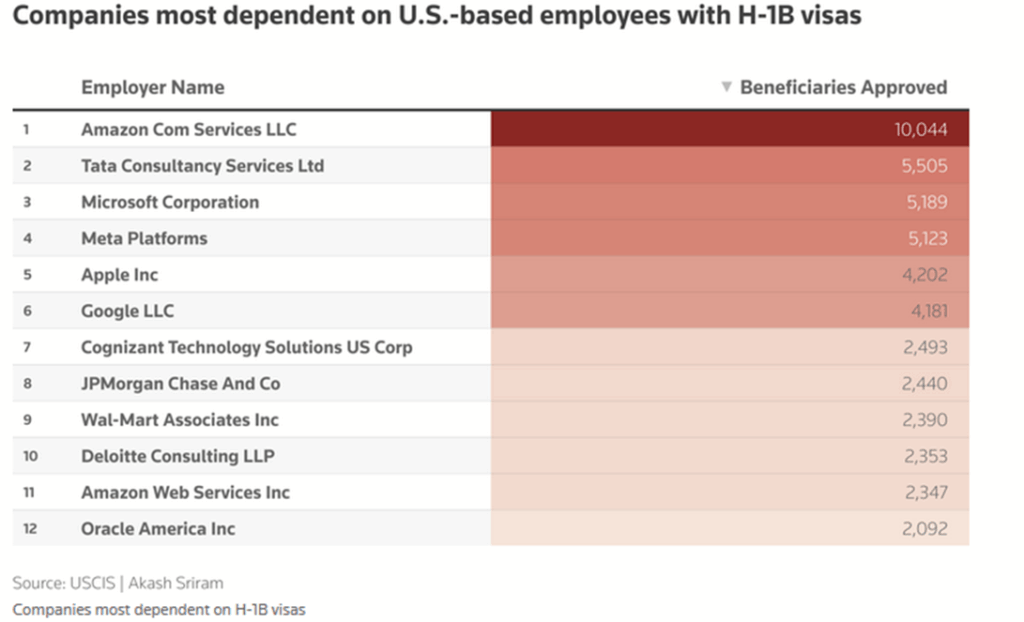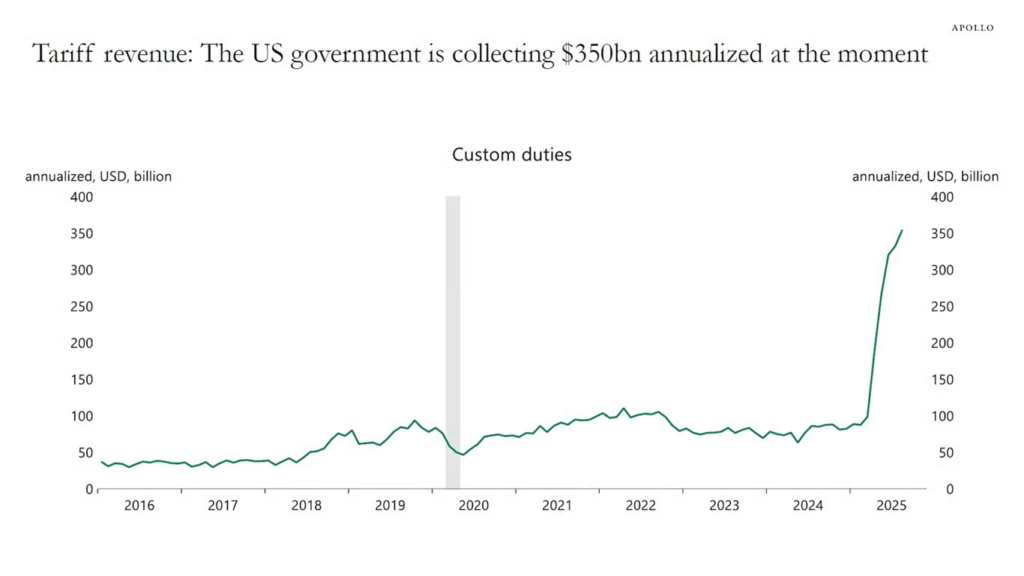1. History of Small Cap During Similar Rate Cuts by Fed
Dorsey Wright When the Federal Reserve has implemented interest rate cuts spaced more than 100 days apart since 1990, historical returns indicate that small-cap equities, represented by the iShares Russell 2000 ETF (IWM), deliver strong forward returns. Although near-term returns (1–3 months) are often muted, IWM’s average returns are 16% at one year and 32.7% at two years, as shown in the table below. For investors aiming to diversify beyond the S&P 500 (SPX), IWM presents an opportunity to gain exposure in a different areas within U.S. equities.

NASDAQ DORSEY WRIGHT
2. Goldman Sachs Retail Favorite Buy Stocks…Record Consecutive Days of Gains
Sherwood News

Sherwood
3. Tech is Dependent on H-1B Visas…Majority from India


CNBC
4. 40-50% of Venture Funds Suffering a Loss Relative to NAV

PitchBook
5. PYPL has Reduced its Share Count by 1/5 in 5 Years

Koyfin
6. U.S. Dollar to Swiss Franc Trades Down to 2023 Lows

StockCharts
7. American Imports From China 21% to 9% Less than 10 Years

Semafor
8. Chinese Made EVs Big Market Share Gains in Asia

WSJ
9. Fantastic 4 Movie 3200 Employees?? Prof G

PROF G MEDIA
10. Brain Health and Mental Capacity Depend on Physical Activity
Our executive and emotional skills remain connected to activity by evolution. Sarah Gingell Ph.D.
Key points
- The evolution of adaptations for physical activity and cognitive and emotional skills are intertwined.
- Physical activity remains a key driver of brain health, while inactivity reduces cognitive resources.
- This “evolutionary bug” has revealed itself only as sedentary lifestyles have become possible.
Nowadays, no one seriously doubts that physical activity improves our physical health, along with our mental health and cognitive abilities.
Physically active children perform better in school, achieving better academic outcomes than less active children. Active kids also typically have better mental health, with improved self-esteem, social confidence, and emotional regulation, and lower levels of stress, anxiety, and depression. Sedentary adults who start exercising show improvements in attention, memory, and thinking skills, in addition to improved mood and mental health conditions such as depression. Older adults who have been physically active throughout their lives tend to have higher physical and mental well-being, lower levels of neurodegenerative conditions, and retain sharper minds.
But have you ever wondered why?
We are familiar with the idea that our bodies adapt to functional demands. When we are new to running, we are initially unable to meet our muscles’ increased oxygen demand. However, with continued training, new blood vessels develop to supply more oxygen-laden red blood cells, and we breathe more easily. Muscles and bones would grow stronger, the lungs would become more efficient, and many other metabolic and energy management adaptations would occur.
It is often assumed that exercise improves brain health only as a beneficial side effect of these adaptive bodily changes. For example, better cardiovascular function increases cerebral blood flow, enhancing oxygen and nutrient delivery to better support the health of brain cells. However, recent research is clear that many of the exercise-related chemical factors produced by the muscles, bones, liver, and other tissues also target the brain directly. Some of these “exerkines” and metabolites might one day form part of an ‘exercise pill’ to protect brain health.
Why does our brain respond to physical activity in such a direct way?
The fascinating answer may date to around 2 million years ago, when our ancestors descended from the trees and developed skills to move and survive on the ground. The neuroscientist and anthropologist David Raichlen argues persuasively that “we evolved to be cognitively-engaged endurance athletes.”
As early humans developed physical adaptations for walking, running, and aerobic activity, they also developed skills for hunting and foraging. Foraging and persistence hunting—which could involve tailing animals for days—requires planning, organisation, and focus. We recognise these skills in our modern “executive functions” of working memory, cognitive flexibility, and self-control. Physical endurance also depended on constructively managing exhaustion, fear, and anxiety, flexibly responding to setbacks, maintaining focus, not giving up, and so on, all key aspects of emotional regulation.
What began as neural circuits for reflexive movement control gradually expanded through evolution in humans into systems in the prefrontal cortex, cerebellum, and basal ganglia that support flexible activity, abstract thought, and behavioural regulation. Early humans’ evolutionarily adaptive responses to the physical and mental demands of hunting and foraging developed in tandem, and remain intertwined in our modern brains.
This might explain how brain systems evolved, but not why day-to-day physical activity remains so important to the brain health of modern man.
Gerd Kempermann has argued that for our ancestors, being on the move was likely to be associated with mental challenges. Responses to physical activity prime neurons for possible learning, through neuroplastic changes that allow neurons to form new connections or reorganise existing connections to record learning. These connections can then be utilised and stabilised by cognitive and emotional tasks, so that repeated pairing of physical and mental tasks builds brain capacity.
But here’s the kicker.
Because movement wasn’t optional for our ancestors to survive and did not need to be encouraged, evolutionary pressures favoured energy conservation when possible.
This means that we lose energy-consuming capacity when it is not needed.
We are familiar with the idea that unneeded muscle strength and bulk are lost if we don’t exercise. Unfortunately, something similar occurs in the brain. If we are chronically inactive, the hippocampus shrinks more quickly, accelerating age-related cognitive decline. BDNF production is suppressed, limiting the capacity to learn. Levels of mood-enhancing neurotransmitters such as dopamine, serotonin, and norepinephrine drop, and the prefrontal cortex shrinks and becomes less efficient, impacting executive functions and emotional regulation.
This “evolutionary bug” is revealed only when sedentary lifestyles become a possibility.
What makes this so problematic is that we are also evolutionarily programmed to be drawn to inactivity to conserve energy (even though calories are abundantly available for most of us). The immediate visceral rewards of sedentary activities, such as eating and relaxing (or cat videos), often outweigh the abstract delayed benefits of fitness, such as long-term health improvements, when we have the choice.
Daniel Lieberman has pointed out that we are not well-equipped by evolution to “choose” exercise. One option is to change our environment so we have no choice but to move—our ancestors’ path to exercise. We might take the stairs, park a few blocks away from work, or sell the car… Another option is to make activity more pleasurable so that we want to do it. Start by dancing in the kitchen, walking with friends, trampolining with the kids, or working out with brilliant music and cool clothes.
The key is to start. Once we rouse ourselves into action, evolution has a neat trick to keep us going.
Even a short bout of aerobic exercise, a walk, or light stretching increases dopamine and BDNF release, enhancing mood and motivation and reducing stress. This reward reinforces learning behaviours by making them feel pleasurable, which encourages repetition.
More consistent exercise leads to a general upregulation of dopamine function, which strengthens the overall responsiveness of all reward pathways, not only those involved in exercise. So life in general starts to feel better. This is why exercise can be an effective treatment for depression, addiction, and other mood disorders. Exercise itself acts as a natural reward booster, with the added benefit of neuroplasticity, helping the brain form healthier motivational patterns.
We’ve been built to need to move. And moving more means you’ll like moving more, and everything in life will feel better. This is the real incentive.



































